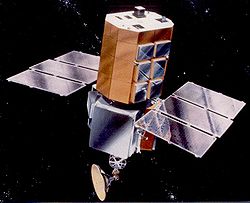- Solar Max
-
Solar Maximum Mission
Solar Maximum Mission Caractéristiques Organisation NASA Domaine Observation solaire Masse 2 315 kg Lancement 14 février 1980 à 15:57 UTC Lanceur Delta Fin de mission 2 décembre 1989 (rentrée dans l'atmosphère) Durée {{{durée}}} Durée de vie {{{durée de vie}}} Désorbitage {{{désorbitage}}} Autres noms {{{autres_noms}}} Programme {{{programme}}} Index NSSDC 1980-014A Site {{{site}}} Orbite Orbite terrestre Périapside 508 km Périgée {{{périgée}}} Apoapside 512 km Apogée {{{apogée}}} Altitude {{{altitude}}} Localisation {{{localisation}}} Période 94,8 min Inclinaison 28,5° Excentricité {{{excentricité}}} Demi-grand axe {{{demi-grand axe}}} Orbites {{{orbites}}} Type {{{télescope_type}}} Diamètre {{{télescope_diamètre}}} Superficie {{{télescope_superficie}}} Focale {{{télescope_focale}}} Champ {{{télescope_champ}}} Longueur d'onde {{{télescope_longueur_d'onde}}} {{{instrument1_nom}}} {{{instrument1_type}}} {{{instrument2_nom}}} {{{instrument2_type}}} {{{instrument3_nom}}} {{{instrument3_type}}} {{{instrument4_nom}}} {{{instrument4_type}}} {{{instrument5_nom}}} {{{instrument5_type}}} {{{instrument6_nom}}} {{{instrument6_type}}} {{{instrument7_nom}}} {{{instrument7_type}}} {{{instrument8_nom}}} {{{instrument8_type}}} {{{instrument9_nom}}} {{{instrument9_type}}} {{{instrument10_nom}}} {{{instrument10_type}}} {{{instrument11_nom}}} {{{instrument11_type}}} {{{instrument12_nom}}} {{{instrument12_type}}} Le satellite Solar Maximum Mission (ou SolarMax) a été conçu pour étudier les phénomènes solaires dont les éruptions solaires. Il a été lancé le 14 février 1980.
Sans être unique, le SMM est remarquable par la longueur de sa durée de vie qui a été améliorée par une intervention humaine directe. En 1984, la navette spatiale Challenger (mission STS-41-C) l'a intercepté et a amené le SSM à bord de la navette pour une réparation et de la maintenance.
On peut noter que l'instrument ACRIM de SolarMax a montré que, contrairement à ce que l'on pouvait imaginer, le soleil est plus brillant pendant les périodes de maximum de taches solaires (quand il y a le maximum de tâches sombres). Cela vient de ce que les tâches sont entourées de faculae, des structures extrêmement brillantes, qui compensent largement l'assombrissement liées à la tâche elle-même.
Entre 1987 et 1989, la mission découvrit 10 comètes rasantes au Soleil.
La Solar Maximum Mission a pris fin le 2 décembre 1989 quand le satellite est rentré dans l'atmosphère et s'est désintégré.
Voir aussi
Liens externes
- HEASARC, SMM
- JPL, SMM
- Marshall Spaceflight Center, SMM
- Portail de l’astronomie
- Portail de l’astronautique
Catégories : Observatoire spatial solaire | Satellite scientifique
Wikimedia Foundation. 2010.

